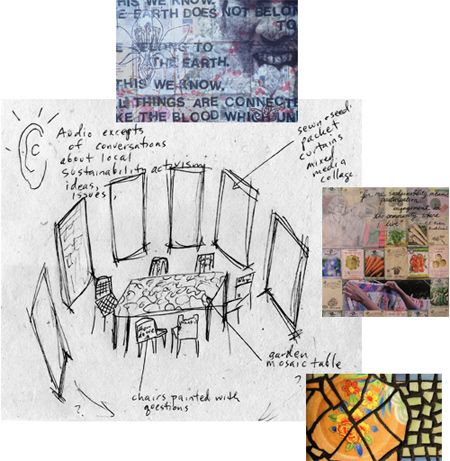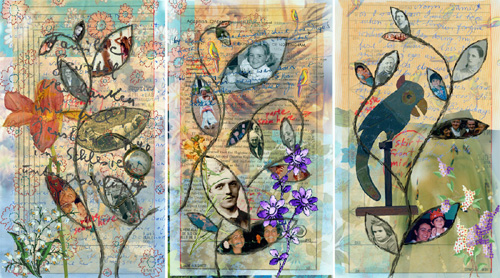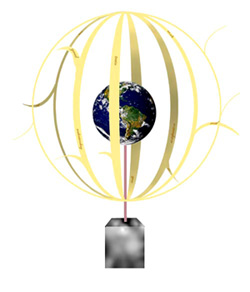“A Table Set For Forever”
by Jane Beatrice Wegscheider
Brief description: “A Table Set for Forever” is a portable, multi-media, installation piece that honors existing individual and collective efforts at sustainability while engaging the viewer/participant with questions, ideas, images and visual metaphors related to sustainability in our region.

“A Table Set For Forever” is a portable, multi-media, installation piece: a kind of permeable “room” that can be set up anywhere. The central visual motif is a table and six chairs. The table top is a garden-theme mosaic made of colored glass tiles and bits of broken plates (pique assiette technique). The mismatched (‘recycled”) wooden chairs are colorfully painted with questions related to sustainability in our region. Six free-standing curtain-like panels in portable frames will be set up around the table. Each of the two-sided panels will be made of a collage of seed-packets sewn together with images (both photographic and drawn/painted) and text derived from relevant literature and local community sources. The panels will be set up around the table and chairs so that people can walk between and around them easily, in and out of the “room”.
An essential part of the piece is that it involves the participation of many other people in its process. I will send out and distribute (in local businesses, libraries, etc.) written requests for participation in the sustainability dialogue, beginning with the question: “What does sustainability mean to you?” I will ask for examples of sustainable activities people are involved in in our region, and ideas for more. This request will also be sent out digitally.
I will also organize and facilitate ten conversations around the table (and a local foods meal). For each conversation, I will bring together groups of six people from varying segments of our communities to share their ideas and brainstorm further sustainability activism. These conversations will be recorded and excerpts from them will become the audio component of the installation, as well as source material for the seed-packet collage panels.
My basic premise is that dialogue/conversation/the sharing of ideas (especially person to person) is essential to sustainable activism. Sharing thoughts and ideas around a shared meal is a way to combine activism with community-building. In the conversation about sustainability, we are also talking about basic needs and resources, of which, food is one primary need.
I’m also convinced that small actions need to be honored along with bigger systemic efforts. People change and accept change in different ways. My aesthetic is generally an “accessible” one. The seed-packet “curtain”/panels will show the significance of ALL actions, ideas, questions, etc. that collectively add up. Even on their own these panels will be a stimulating and informative visual discussion.
the table as metaphor
the table as place
the table as community, family, the future
the table shared
the table abundant
the table as an edible landscape
I will use the pique assiette technique (broken plate mosaic), along with the garden theme, to refer to the past that is a part of us.
The chairs have questions painted on them to represent the challenges of joining the sustainability discussion/dialogue/effort.
The “walls”/ “curtains”/ panels are permeable to suggest visually that this is not a behind-closed-doors conversation. The seed packets are a literal metaphor: seeds produce multiples of themselves. They symbolize growth and potential.
The installation is purposely portable, each element breaking down into carry-able pieces so that it can more easily become part of various local environments/public spaces: farmer’s markets, schools, outdoor cultural events, etc.
I hope that the September 30th installation of the piece will be the first phase of this project. The second phase will involve developing the audio component further for web and radio and developing ways to use the installation to disseminate physical cards (for people to take with them) with ideas and information on them. (I can imagine letter-pressed “information” on vegetable-shaped cards in bowls on the table.) The third phase would be to organize and facilitate having the installation travel to schools, libraries, farmer’s markets and other public venues.
I have experience and skills creating and facilitating “accessible”, community-building, art projects that embrace the social, economic and cultural diversity that is part of every community. I am excited about this project because it brings together these skills with my own passions about local sustainability issues. As an interdisciplinary artist, this project also employs my varied interests and abilities in photography, collage, audio recording, sculpture, painting and installation. I am hopeful that both the process of creating the work and the final product will help further regional efforts at sustainability.
Example of Previous work:
EXPERIENCE
Education
School of the Art Institute of Chicago, IL 1989-1992
Master of Fine Arts: Painting 1992
Post-Baccalaureate Certificate: Painting 1990
Erlangen University and Berlin University of Technology, Germany 1983-1986
Enrolled in German language courses and Art History program
Wheaton College, Wheaton, IL 1980-1982
Bachelor of Arts: Art 1982
Medill School of Journalism, Northwestern University, Evanston, IL 1978-1980
Awards and Residencies
The Academy at Charlemont, MA 2006
Artist in Residence. Worked with 9th graders to create site-specific public sculpture that reflected qualities and values of the Academy.
The Philanthropic Initiative, Boston, MA 2001, 2003
Awarded Art Renewal for Teachers summer grants. 2001: travel in Europe to explore personal and artistic heritage (photography, journaling and collage). 2003: interdisciplinary exploration of local citizens’ connections to place. Awarded an in-school grant to develop and facilitate a
K-6 photography program Documenting Our Worlds (2002).
Raymer Society for the Arts, Lindsborg, KS July 1999
Artist in Residence at Lester Raymer’s Red Barn Studio.
Ragdale Foundation, Lake Forest, IL July 1998
Awarded residency to explore relationships between landscape, memory and myth.
Salina Arts and Humanities Commission, Salina, KS 1997-1998
Artist in Residence with Arts Infusion program in Salina’s public schools.
Lawrence Art Guild, Lawrence, KS 1997
Received Advancement Award for Scenes from a Life in the Middle of America, collage paintings.
Salina Art Center, Salina, KS June 1996
Artist in Residence: Art and the Environment collaboration with the Land Institute.
Kansas Arts Commission, Topeka, KS 1996
Awarded Mini Fellowship for Interdisciplinary Art.
Intermedia Arts, Minneapolis, MN 1994
Awarded Diverse Visions Regional Interdisciplinary Grant for series of outdoor performances and garden installations related to seasonal celebrations.
Skowhegan School of Painting and Sculpture, Skowhegan, ME 1992
Awarded School of the Art Institute Fellowship to attend.
School of the Art Institute of Chicago, IL 1989-1992
Awarded Partial Merit Scholarship for Post-Baccalaureate program in 1989-1990.
Awarded Teaching Assistantships in 1991 and 1992.
Awarded Full Merit Scholarship for 1991-1992.
Awarded Edward L. Ryerson Fellowship for MFA Thesis Installation.
Artist Collaborations with Communities
Harold Grinspoon Foundation, West Springfield, MA 2006
One of 15 artists/artist groups selected by jury to create a panel for the Jewish Arts and Culture Initiative Sweet Shelter Art Project, a community sukkah exhibited at the Yiddish Book Center in Amherst. Panel reflected my ongoing collaboration with local CSA farmer, John Hoffman, using photographs from Wilder Brook Farm (Community Supported Agriculture) and text transcribed from video interviews with Hoffman.
Massachusetts Cultural Council, Boston, MA 2003-2004
Creative Schools Grant Artist in Residence at Heath Elementary School. Worked with students staff and local community to create A Book You Walk Through; an interactive, mural-sized, hinged-paneled installation integrating Massachusetts’ Curriculum Frameworks with the local environment, culture and history.
Heath Elementary School, Heath, MA 2000-2001
Received Goals 2000, Schools, Families and Communities Working Together Grant to do Heath Community Heritage Project. Designed and facilitated community and teacher workshops, recorded local oral histories on video, and facilitated the making of a 9’x50’ mural painted by 80 people from the community (ages 4-75).
Heath Elementary School, Heath, MA 2000
Received Goals 2000, Schools, Families and Communities Working Together Grant to develop and facilitate an intensive summer workshop program: Sculptured Stories. Each participant created a wooden cut-out sculpture embellished with images related to their personal identity and family heritage. The 22 sculptures were exhibited at the Heath Fair.
Salina Arts and Humanities Commission, Salina, KS 2000
Commissioned to create Field of Visions, an interactive installation for the Smoky Hill River Festival. Work involved inviting people to document their hopes and dreams for the future on strips of cloth. Installation was also exhibited at the Heath Fair and the Heath School grounds.
Salina Bicentennial Community Center, Salina, KS 1999
Commissioned to design and paint a permanent mural in the entry area of this multi-function arena. Through local media and presentations in public venues and schools, I invited residents to share what they loved about their community and environment. Written and oral responses and historical information are incorporated into the mural with the traced silhouettes and photographed faces of community members. The mural is included in the illustrated, Kansas Murals: A Traveler’s Guide, published by University Press of Kansas (2006).
Smoky Hill River Festival, Salina, KS 1997-1999
Commissioned to create interactive outdoor sculptures using silhouettes and faces of local children. Butterfly Bridge/Angel Archway (1999): 2 silhouette-shaped sculptures with welded electrical conduit wings perched on the railings of a walking bridge, forming an archway that Festival-goers passed under; River Mermaids (1998): 3 silhouette-shaped fountains addressing recycling issues “swam” in the river; Balancing Act (1997): 12 silhouette-shaped sculptures playfully addressing relationships in nature were “planted” in the Festival’s park landscape.
The City Museum, St. Louis, MO 1997
Commissioned to create a permanent installation of interactive sculptures that honored the work and personalities of the directors, staff, artists and laborers who were collectively putting this new museum together.
Teaching Experience
The Academy at Charlemont, MA 2006-2008
Teach 10th-12th grade studio courses in Book Arts, Papermaking, Printmaking, Drawing and Painting, Mural Painting and Independent Studio Projects. Work includes mentoring and advising seniors preparing portfolios for college applications.
Hawlemont, Rowe, and Heath Elementary Schools, Franklin County, MA 2000-2008
Certified K-6th Grade Art Teacher: Hawlemont and Rowe (2000-present), Heath (2000-2003).
Work includes developing K-6 Art curriculum, collaborating on interdisciplinary projects with classroom teachers, assessing student progress, adapting curriculum for students with special needs, ordering supplies, applying for and coordinating available grant-funding, and developing and coordinating a Visiting Artist program (Rowe 2003-2004).
Boys and Girls Club of Lawrence, Lawrence, KS 2000
Worked collaboratively with colleague Lora Jost to develop and facilitate a mural project in the after-school program at the Club. Work included guiding children through brainstorming, design and transfer of large-scale images, and collaborative painting on the walls of the Club’s art room.
Douglas County Juvenile Detention Center, Lawrence, KS 1997-1999
Developed and taught interdisciplinary art curriculum to teenage criminal offenders.
Van Go Mobile Arts, Inc., Lawrence, KS 1998
Worked with colleague Lora Jost to develop and facilitate an after-school art program for at-risk youth to collaboratively paint Van Go’s signature vehicle (an 8-doored Checker Aerobus.) Work included guiding teenagers through the brainstorming and design process, transferring their designs to the vehicle’s irregular surface and painting with permanent acrylics. This 8-week project culminated with participation in the local Art-Car Parade.
Lawrence Arts Center, Lawrence, KS 1996-1998
Developed and taught Drawing I, Mixed-Media and Interdisciplinary Adult classes. Developed and taught Preschool Ceramics and Preschool Painting classes based on connections to children’s literature.
Manhattan Arts Council, Manhattan, KS 1995-1996
Developed and taught childrens’ classes in Ceramics and Mural Painting.
Sampsel Studio, Council Grove, KS 1995-1996
Developed and facilitated my own after-school arts program. Children worked in a variety of media, including ceramics, collage and large-scale painting.
School of the Art Institute, Chicago, IL 1991-1992
A limited number of Teaching Assistantships were awarded to graduate students each year at SAIC, chosen by the faculty of each department. In 1991, I assisted Professor Susanna Coffey with her undergraduate Figure Painting course. In 1992, I developed the curriculum and taught my own undergraduate Figure Drawing course.
Berlin, Germany 1983-1986
Taught English as a Second Language in private and small-school settings.
Lexington Christian Academy, Lexington, MA 1982-1983
Taught 10th grade English and 7th-12th grade Art.
Exhibitions, Performances, and Installations
Women of the Cloth, Group Show, Bunker Hill Community College, Boston, MA, 3/08-4/08.
Sweet Shelter, Outdoor Installation, Yiddish Book Center, Amherst, MA, 10/06.
A Book You Walk Through, Installation, The Children’s Museum, Holyoke, MA, 10/04-4/05.
Show Us Your Bra, Group Show, Thornes Marketplace Gallery, Northampton, MA, 10/03.
Off the Bed: Quilts Not for Sleeping, Group Show,The Art Bank, Shelburne Falls, MA, 11/01.
Heath Community Heritage Mural, Outdoor Installation, Heath Fair, Heath, MA, 8/01.
Sculptured Stories and Field of Visions, Outdoor Installations, Heath Fair, Heath, MA, 8/00.
Field of Visions, Outdoor Installation, Smoky Hill River Festival, Salina, KS, 6/00.
What Do You Love About This Place? Mural, Bicentennial Center, Salina, KS, 10/99.
Butterfly Bridge/Angel Archway, Installation, Smoky Hill River Festival, Salina, KS, 6/99.
River Mermaids, Outdoor Fountain Installation, Smoky Hill River Festival, Salina, KS, 6/98.
Unbridled, Group Show, Michael Cross Gallery, Kansas City, MO, 10/97.
Reaching for the Stars, Permanent Installation, City Museum, St. Louis, MO, 10/97.
Dirty Laundry, Collaborative Group Performance, Morgan Gallery, Kansas City, MO, 7/97.
Balancing Act, Interactive Outdoor Installation, Smoky Hill River Festival, Salina, KS, 6/97.
Red Carpet, Collaborative Group Performance, Kansas University, Lawrence, KS, 5/97.
Through Women’s Eyes, Group Show, Holt/Russell Gallery, Baldwin City, KS, 3/97.
Depicting Women, Group Show, Moss-Thorns Gallery of Art, Hays, KS, 1/97.
Through Women’s Eyes, Group Show, Mulvane Art Museum, Topeka, KS, 8/96.
Three Women, Group Show, Butler County Community College, Council Grove, KS, 5/96.
Women’s Works, Group Show, Manhattan Arts Center, Manhattan, KS, 2/96.
Hope Springs Eternal, One Person Show, Kansas State University, Manhattan, KS, 10/95.
Another Man’s Treasure, Group Show, Zografia Gallery, Kansas City, MO, 8/95.
Depicting Women, Group Show, Kansas State University, Manhattan, KS, 7/95.
MayDay, Outdoor Installation and Performance, Alta Vista, KS, 5/95.
Creative Synectics, Juried Group Show, An Art Place, Chicago, IL, 8/94.
One Person Show, Adam’s Hall Gallery, Wheaton College, Wheaton, IL, 11/92.
Chicago Art Institute MFA Exhibition, Group Show, Juried Award Recipient, Chicago, IL, 5/92.
For Mary, Interactive Outdoor Installation and Performance, Lincoln Park, Chicago, IL, 4/92.
Panels and Workshops
The Philanthropic Initiative, Boston, MA 2002-2008
Member of annual Grant Review Panel for Art Renewal for Teachers Grant Program.
Heath Elementary School, Heath, MA 2002-2003
Member of EIC Advisory Panel (EIC: Environment as an Integrating Context for Learning.)
Christians in the Visual Arts Conference, Milwaukee, WI June 1999
Panelist in workshop: The Figure in Context: Spiritual, Social and Ecological Implications.
Parents As Teachers, Lawrence, KS May 1999
Developed and facilitated parent workshop: Creativity, Children and Brain Development.
The Quiet Garden, Keats, KS May 1996
Panelist in conference: Land and Soul.
Salina Art Center, Salina, KS 1995
Developed and taught workshop in conjunction with Betye Saar Exhibit: Personal Images.
Professional Development and Related Extracurricular Activities
Westfield State College, Westfield, MA 2007
Student in graduate level Education course: Students with Special Needs.
Bridgewater State College, Bridgewater, MA 2006
Participant in 45-hour graduate level Summer Content Institute New Technologies in the
Visual Arts (Photoshop) sponsored by the Massachusetts Department of Education.
Mohawk Trail Regional School District, Buckland, MA 2005-2006
Participant in 54-hour Picture Writers professional development program which explored
Visual Literacy and Technology in collaboration with the Eric Carle Museum and Smith
College. I developed curriculum in Digital Collage and Animated Digital Collage.
Bennington College, Bennington, VT 2004
Participant in Art New England Summer Workshop: The Book as Art.
UMass, Dartmouth and The Schooner Ernestina, New Bedford, MA 2002
Participant in 97-hour graduate level Summer Content Institute EIC: Using the Environment
as an Integrating Context for Learning. Course involved field-based study in New Bedford,
curriculum development, student assessment strategies, and implementation of EIC at Heath
Elementary School. Sponsored by the Massachusetts Department of Education.
Lesley University, Cambridge, MA 2001-2002
Participant in Leading With The Arts conferences and workshops.
Columbia School of Dance, Chicago, IL 1990-1991
Collaborated with choreographer Ann Boyd. Designed and created sets and costumes.
Druckwerkstatt, Berlin, Germany 1984-1986
Professional development in private Printmaking studio: Intaglio process.
Hochschule der Kunst, Berlin, Germany 1983
Independent student: Figure Drawing.
School of the Museum of Fine Arts, Boston, MA 1982-1983
Professional development in Printmaking: Etching and Monoprint.
The Art Student’s League, New York, NY 1981
Independent student in summer Figure Drawing class.
Northwestern University, Evanston, IL 1978-1980
Organized and facilitated student-run Figure Drawing workshops.
Activism and Social Service
International Walk for a Peaceful Future in the Middle East, Israel/Palestine 1992
One of 300 delegates from around the world participating in this 5-day Walk. Created a wearable “coat” out of handkerchiefs signed by sponsors.
Clinic Liaison, Healthcare for the Homeless, Chicago, IL 1987-1988
Provided counseling, referral and advocacy to homeless people in drop-in centers, shelters, and on the street. Helped train new staff.
Wheaton College, Wheaton, IL 1981-1982
Helped organize student campaign to revitalize Art Department, leading to increased funding for the department and renovation of its facilities.
Extensive travel in Europe and Mexico. Lived in Berlin 1983-1986. Speak German and Spanish.
 I propose to create a new series of impressionistic nature photographs and a new 3-minute digital story including these new images expressing the theme of sustainability.
I propose to create a new series of impressionistic nature photographs and a new 3-minute digital story including these new images expressing the theme of sustainability.





 The piece I am proposing is a freestanding sculpture consisting of four rings of laminated wood approximately four ft. in diameter on a base of Vermont marble. Inside these rings is a glass sphere, approximately one ft. in diameter in the colors of the planet Earth.
The piece I am proposing is a freestanding sculpture consisting of four rings of laminated wood approximately four ft. in diameter on a base of Vermont marble. Inside these rings is a glass sphere, approximately one ft. in diameter in the colors of the planet Earth.